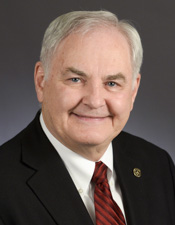House Capital Investment Committee approves $600 million bonding plan
Amid concern about its size — or lack thereof — the House Capital Investment Committee approved a $600 million bonding plan Wednesday night.
Sponsored by Rep. Dean Urdahl (R-Grove City), HF892, as amended, was approved on a split voice vote. It next goes to the House Ways and Means Committee.
“This is a starting point to what we are doing,” Urdahl said, noting expected future negotiations with Gov. Mark Dayton and others. “This bill will change. … I can’t say what number, but it will be bigger than today.”
Rep. Lyndon Carlson Sr. (DFL-Crystal) noted the House Budget Resolution provides $800 million for a capital investment bill.
“The number I’ve been given tonight is $600 million,” said Urdahl, the committee chair.
“To say many of us are disappointed in the size of this bill would be an understatement,” said Rep. Raymond Dehn (DFL-Mpls). “I hope you fight hard with your leadership to increase this dollar amount.”
More than 30 DFL amendments were offered. All were withdrawn or defeated.
By law, capital investment bills need three-fifths supermajority approval, 81 votes in the House, to be enacted. Republicans hold a 77-57 seat advantage.
About 81 percent of the bill is for infrastructure, including $240.2 million for transportation work, $139.8 million for water-related projects and $106 million for facilities preservation.
MORE See the spreadsheet
Dayton unveiled a $1.5 billion proposal in January. Sponsored by Sen. David Senjem (R-Rochester), SF210, a $1.6 billion proposal — including $744.5 million in general-obligation bonding and $201.9 million in General Fund spending — awaits action by the full Senate.
Myron Frans, commissioner of Minnesota Management and Budget, said more than $3.7 billion in requests were submitted.
“We have the resources to make these investments for the projects to help Minnesota move forward,” he said.
Odd-numbered years are traditionally focused on establishing a state budget with a smaller bonding bill; even-numbered years are often centered on a large capital investment plan.
“Most of what we are doing … is what should have passed into law last time,” Urdahl said.
Things went awry just before the curtain closed on the 2016 session, leading to no capital investment bill.
A House vote was taken in the chaotic final minutes of the final day on a plan introduced a few hours earlier. The DFL-controlled Senate added a plan to pay for the controversial Southwest light-rail project just before the clock struck midnight, but the House had adjourned sine die. Capital investment was part of the unsuccessful special session discussion over the final seven months of 2016.
Urdahl said he doesn’t want to see a repeat.
“If I had my druthers, heck, we’d do the bill next week. … I don’t want to come in the last night of session with this bill and have what happened happen again,” he said.
Some DFL members noted that last year’s failure meant a lost construction season and potential higher construction costs.
“We have low interest rates, and if we don’t take advantage it will cost Minnesota millions of dollars,” Carlson said.
Funding in the proposal includes:
- $59.25 million for the local road improvement program;
- $59 million for local bridge replacement;
- $57.02 million for rail grade separation crossings in Moorhead and Red Wing on crude oil rail corridors;
- $40 million in wastewater infrastructure;
- $32.48 million for the Minnesota State system, including $25 million in asset preservation;
- $30 million in asset preservation at the University of Minnesota;
- $15 million for Department of Natural Resources asset preservation;
- $11.5 million for four flood hazard mitigations; and
- $10 million for public housing rehabilitation.
MORE Map of selected projects in the bill
Nearly 70 people testified before the committee, most lamenting what the bill lacks. Arguments included meeting immediate needs, further deterioration of collegiate buildings, making better use of our natural resources and loss of federal dollars associated with projects.
Of the notable omissions, is nearly $70.3 million for renovation and expansion at the Minnesota Security Hospital in St. Peter, which houses and treats Minnesotans that courts have civilly committed as mentally ill and dangerous. The amount is in the governor’s bill, while the Senate bill calls for $57.61 million.
Deputy Human Services Commissioner Chuck Johnson said the first phase was funded in 2014. “The longer Phase II is delayed, the harder it is for us to operate.”
A trio of employees spoke to the committee about safety issues, including poor sightlines to view patient activity. Lori Olson, a registered nurse, said staff was assaulted more than 100 times in the past year, some of which resulted in permanent injuries.
Without this funding, the state is “derelict for not providing a safe place for our people to work and people to heal,” said Lynn Butcher, a training and development specialist.
“This is morally something the Legislature needs to step up and do,” said Rep. Jack Considine Jr. (DFL-Mankato). “We need to step up and let them know we’re going to take care of them.”
“It’s an important project and we are certainly going to take a hard look at it,” Urdahl said.
Related Articles
Search Session Daily
Advanced Search OptionsPriority Dailies
Ways and Means Committee OKs proposed $512 million supplemental budget on party-line vote
By Mike Cook Meeting more needs or fiscal irresponsibility is one way to sum up the differences among the two parties on a supplemental spending package a year after a $72 billion state budg...
Meeting more needs or fiscal irresponsibility is one way to sum up the differences among the two parties on a supplemental spending package a year after a $72 billion state budg...
Minnesota’s projected budget surplus balloons to $3.7 billion, but fiscal pressure still looms
By Rob Hubbard Just as Minnesota has experienced a warmer winter than usual, so has the state’s budget outlook warmed over the past few months.
On Thursday, Minnesota Management and Budget...
Just as Minnesota has experienced a warmer winter than usual, so has the state’s budget outlook warmed over the past few months.
On Thursday, Minnesota Management and Budget...

